Georgia WWSCAN Biweekly Newsletter Update 3/1/24
Welcome to the bi-weekly update for WWSCAN partners in Georgia! The samples provided up through 2/26/24 have been processed in the lab and data are on the site at data.wastewaterscan.org.
We have now launched the categorization system for the more recently onboard pathogens, including Rotavirus, Parainfluenza, EV-D68, Candida auris, and Hepatitis A. You'll see those updates in this newsletter, and when you visit data.wastewaterscan.org you will now find that the map view includes information with Wastewater Categorization for all of the pathogen’s WastewaterSCAN monitors. For more information on the Wastewater Categorization methodology, please refer to the About page on the website here and we will discuss this more at next week’s stakeholder meeting (3/8/24).
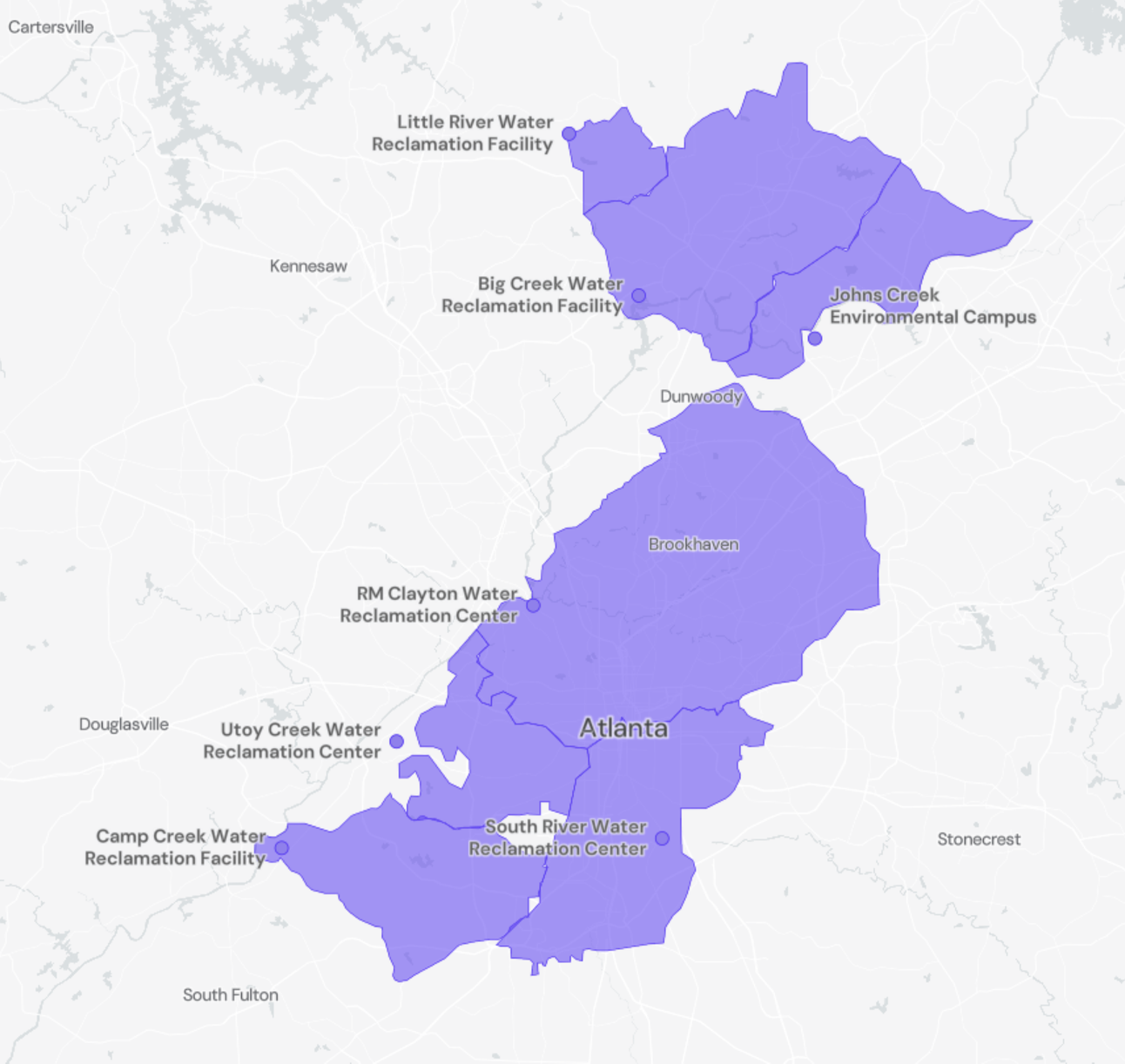
If you notice any bugs on the site or have any comments about it, please continue to send your feedback via email wwscan_stanford_emory@lists.stanford.edu. We thank you for your partnership!
Infectious Disease Target Review
Currently monitoring a suite of Respiratory, Gastrointestinal and Outbreak Pathogens of Concern
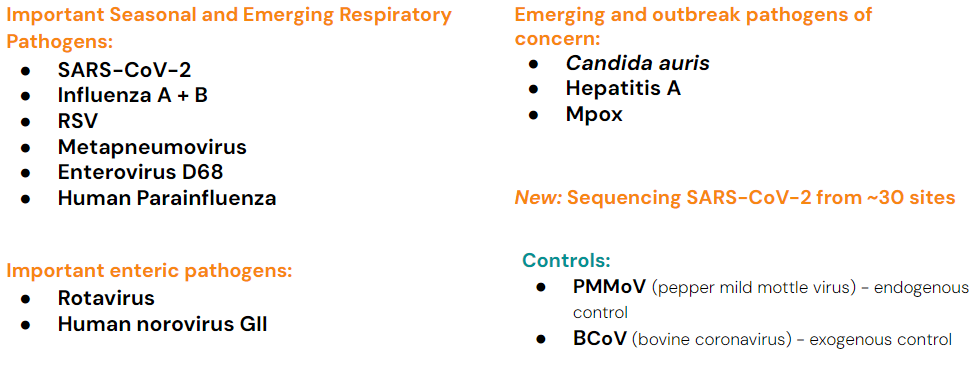
The methods for our assays are in the public domain and links for these are provided at the end of the newsletter.
COVID-19
SARS-CoV-2 concentration in wastewater and sequencing for variants
SARS-CoV-2 RNA concentrations have been between 79,000 and 780,000 copies/gram in the last two weeks. The chart below shows the raw data over the last 365 days and the population-weighted aggregated trend line for all 8 Georgia sites when the data is normalized by PMMoV. The aggregated line and the National Levels benchmarks illustrate that SARS-CoV-2 N gene RNA concentrations among Georgia sites are within the upper third level of all concentrations measured in the last year. As of 3/1/24, College Park, Columbus, Little River, Big Creek, and Johns Creek are in the HIGH (5 sites) Wastewater category. There was not enough data to calculate a category for RM Clayton, Utoy Creek, and South River (3 sites).
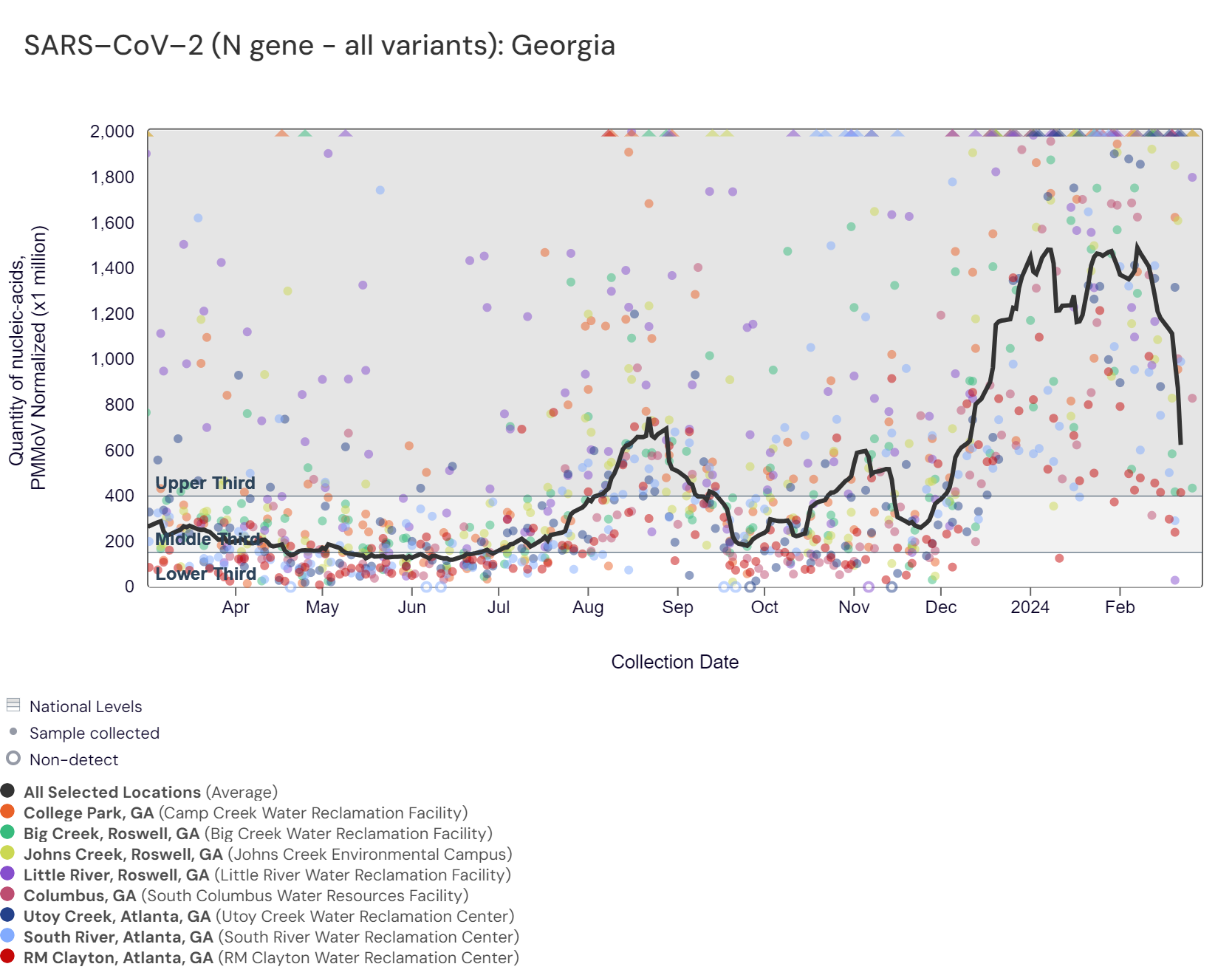
Sequencing of SARS-CoV-2 from wastewater is available for RM Clayton and College Park (Camp Creek). The plots below show the relative proportions of different variants inferred from sequencing the entire genome of SARS-CoV-2 (Note: the sequencing variant plots are now available on the website, so the plots that are shown below are linked above if you want to interact with them). Results are based on sequencing of 2 samples per week, combined to provide a weekly value. Please note that the large gap of "no data" for College Park is because we had data available from preliminary testing while finalizing site selection for sequencing, and then began weekly sequencing in the middle of December.
In the most recent samples, JN.1 (bright red) made up the largest proportion of the lineages detected at both sites (100% at RM Clayton, and 100% at College Park). Note that the most recent data are from two weeks ago (through Feb 17); sequencing data are always from samples taken between 1- 2 weeks ago.
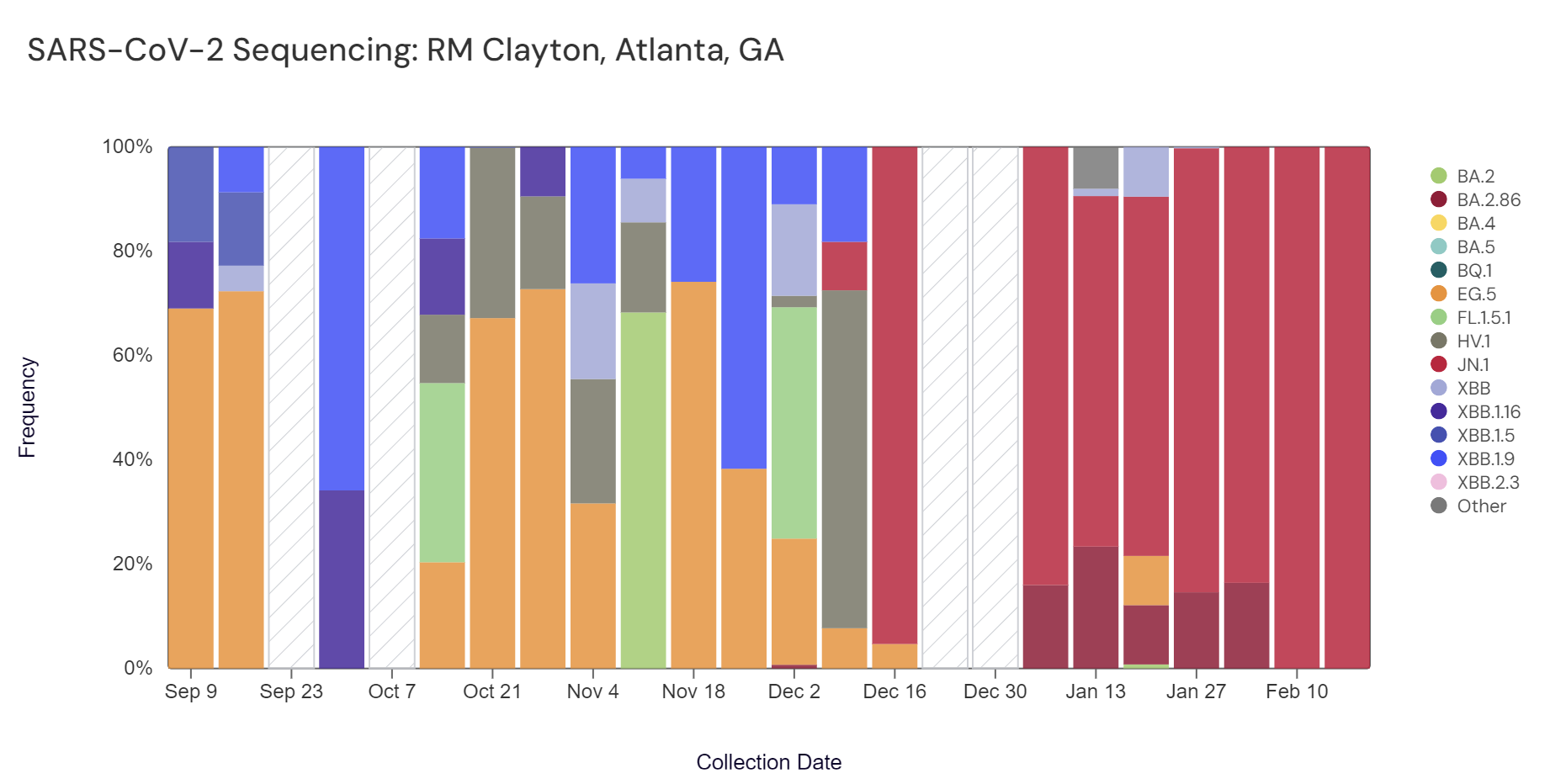
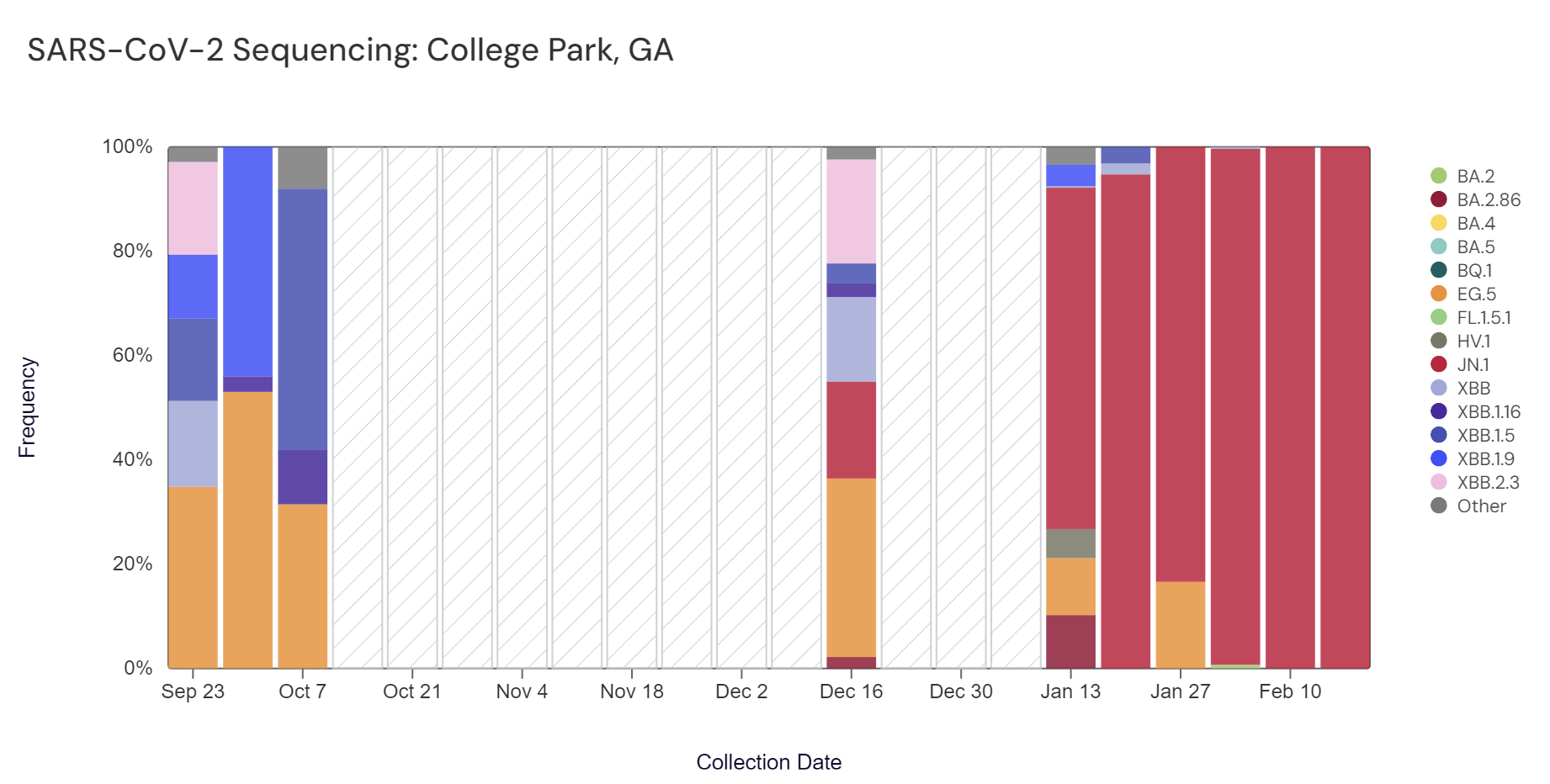
Sequencing data is now also available in aggregate across all sites in WWSCAN with sequencing data. That plot is shown below and also suggests that JN.1 is the most abundant variant across all sites (96.3%).
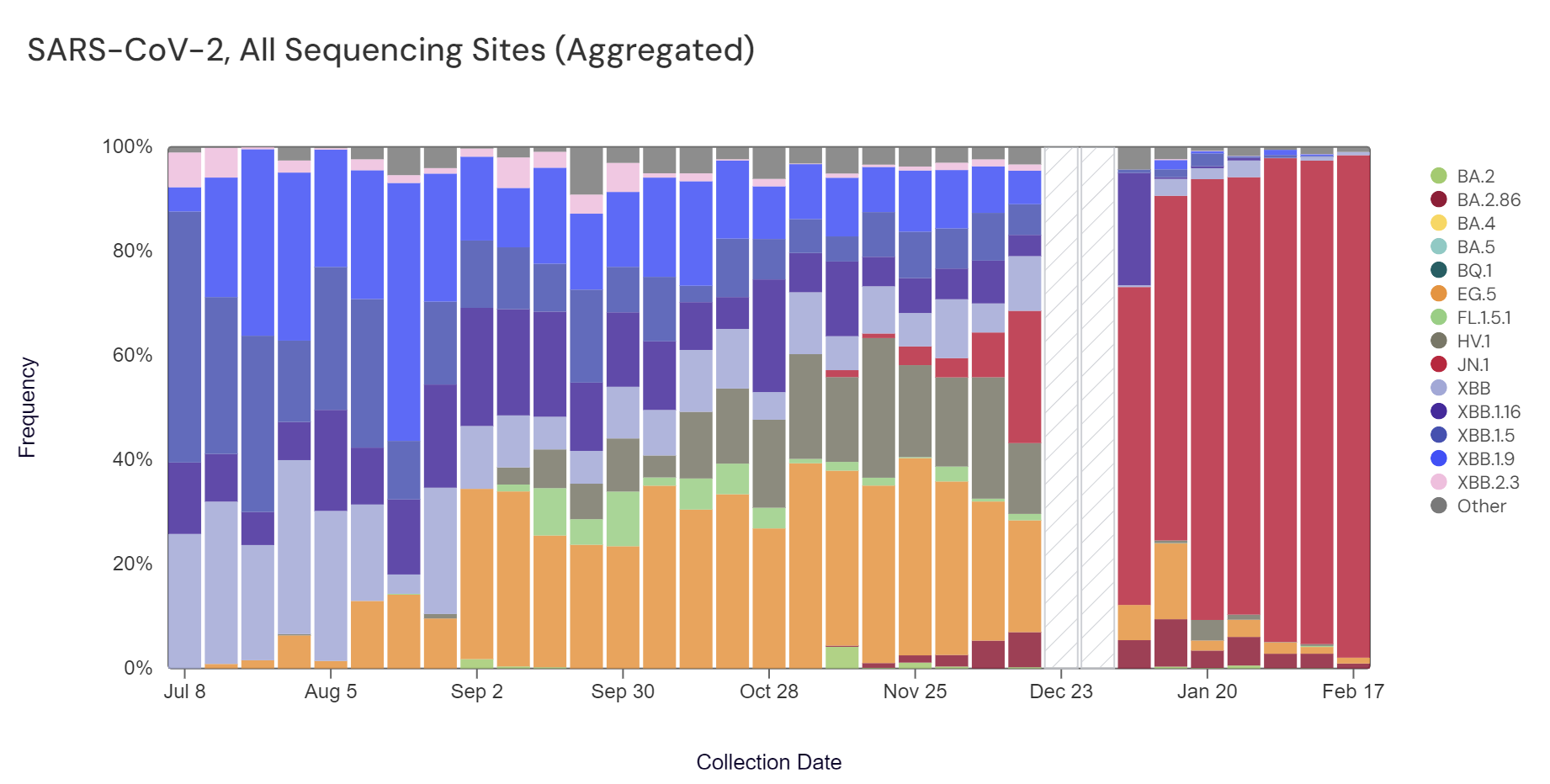
Other Respiratory Pathogens
Influenza A and B, Respiratory Syncytial Virus, Human metapneumovirus, Human Parainfluenza & EV-D68
Influenza A: IAV RNA concentrations have been 8,800 between and 31,000 copies/gram in the last two weeks. The chart below shows the raw data and the population-weighted aggregated trend line for all 8 Georgia sites when the data is normalized by PMMoV. As of 3/1/24, College Park, Columbus, Little River, Big Creek, and Johns Creek are in the HIGH (5 sites) Wastewater category. There was not enough data to calculate a category for RM Clayton, Utoy Creek, and South River (3 sites). IAV RNA wastewater concentrations in the Southern region remain high but there has been a downward trend over the last 3 weeks.
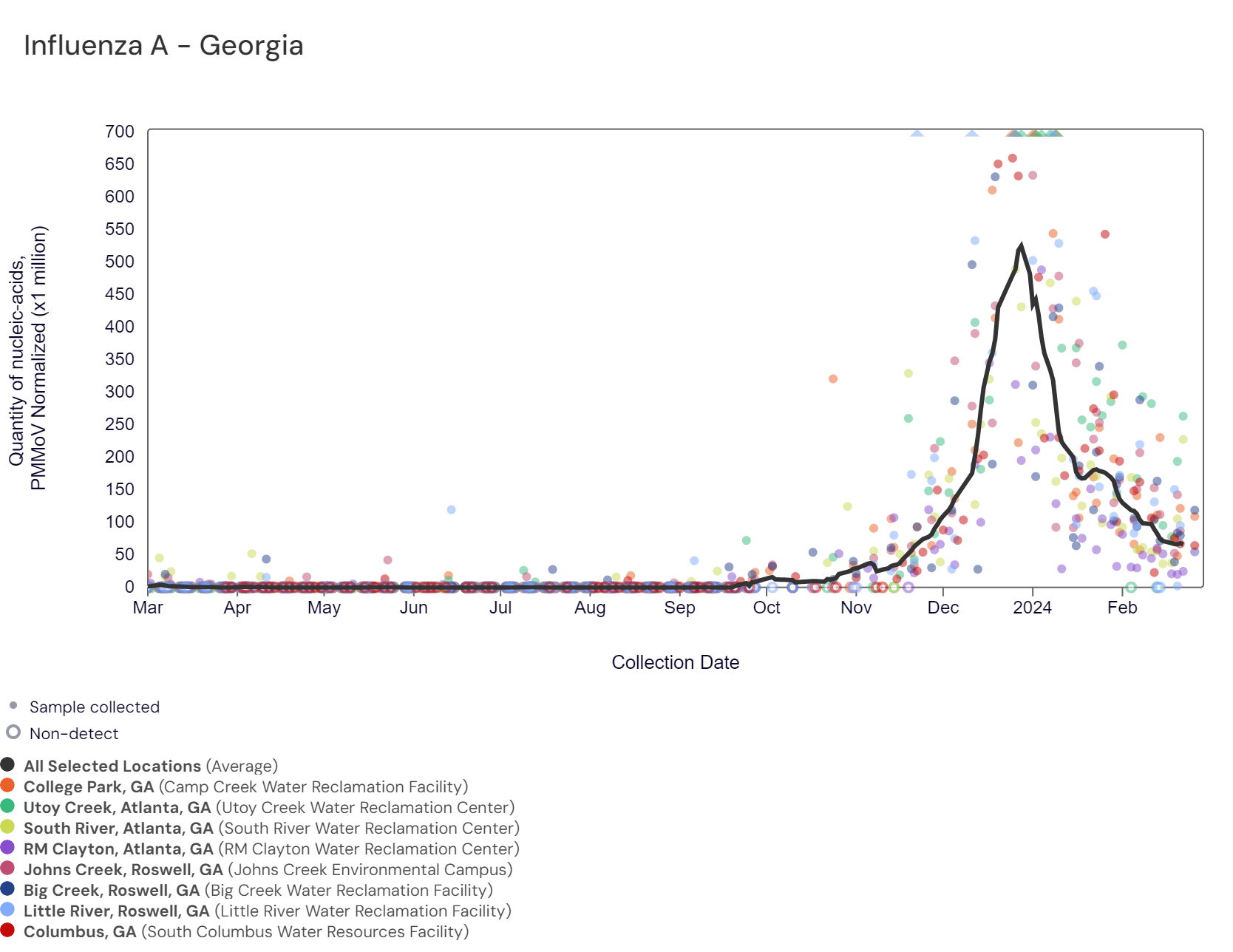
Influenza B (IBV) RNA has been frequently detected at all Georgia sites at low up to high concentrations over the last several months. Levels continue to be much higher than levels around this time last year. IBV RNA concentrations range between 6,900 and 99,000 copies/gram. As of 3/1/24, College Park, Columbus, Little River, Big Creek, and Johns Creek are in the HIGH (5 sites) Wastewater category. There was not enough data to calculate a category for RM Clayton, Utoy Creek, and South River (3 sites). IBV RNA wastewater concentrations in the Southern region are also high but with a downward trend over the last 3 weeks.
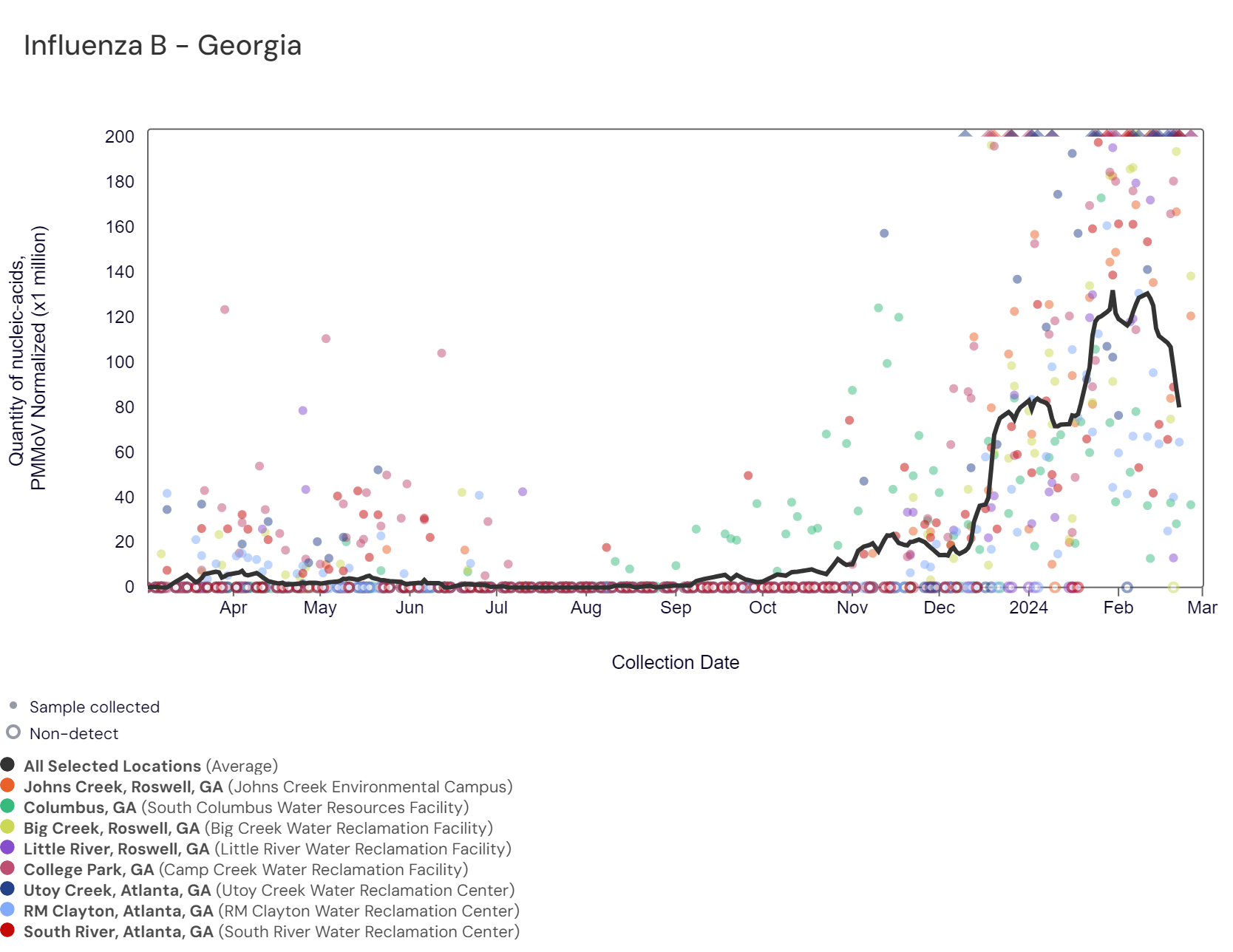
Respiratory syncytial virus (RSV) RNA concentrations were below 34,000 copies/gram over the last two weeks. The chart below includes the raw data for each site since 2023. The aggregated line below is within the dark shaded area, showing that RSV RNA concentrations among Georgia sites are within the upper third level of all concentrations measured in the last year. Levels continue to approach the middle range.
Across the South, RSV is now in the "Low" Wastewater category. In Georgia, as of 3/1/24, College Park, Big Creek, and Johns Creek are in the HIGH (3 sites) Wastewater category. Little River is in the MEDIUM (1 site) category. Columbus is in the LOW (1 site) category. There was not enough data to calculate a category for RM Clayton, Utoy Creek, and South River (3 sites).
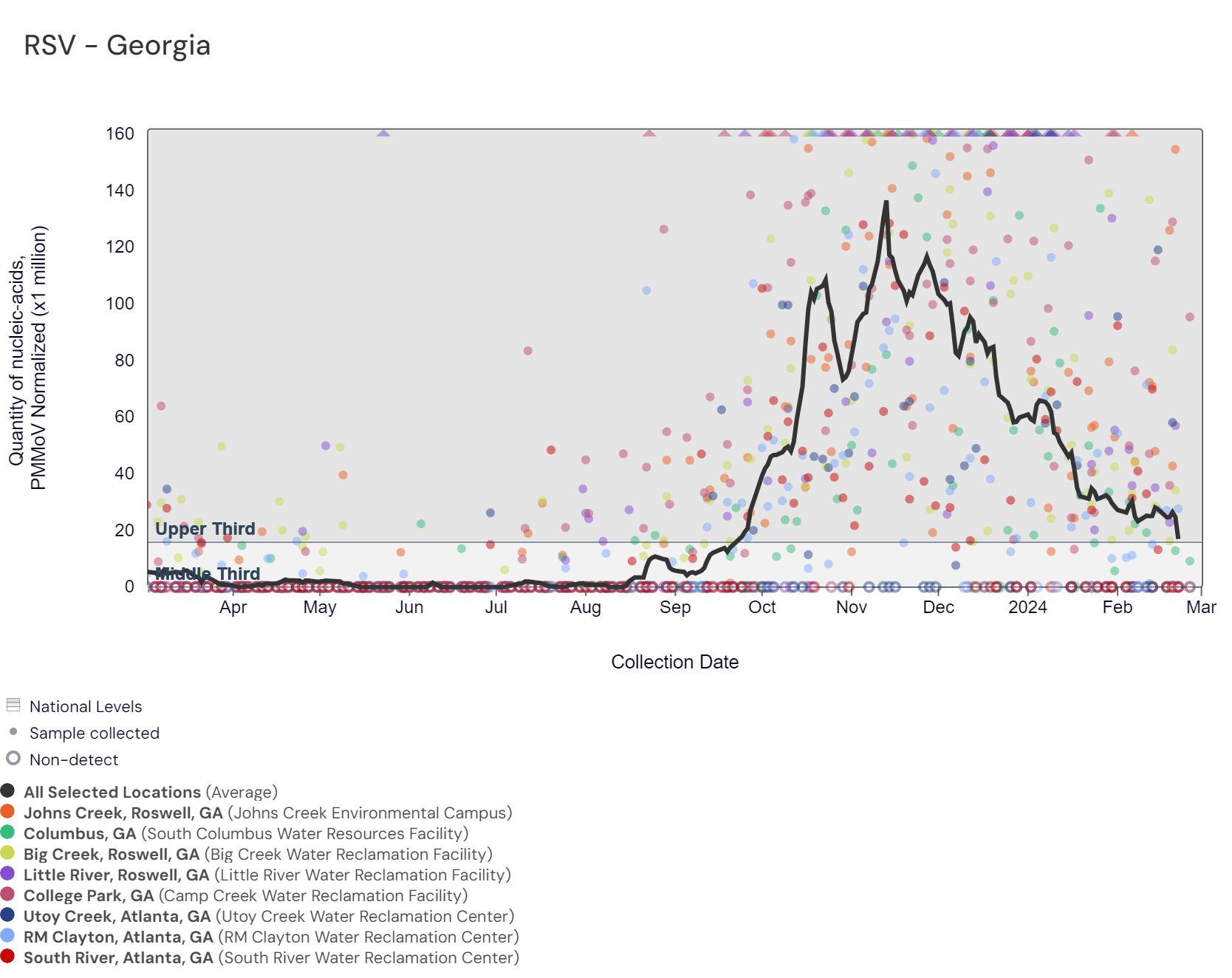
HMPV (human metapneumovirus) RNA concentrations in wastewater are below 42,000 copies/g. Based on the heat map below, HMPV has been detected at all Georgia locations within the last two weeks. HMPV RNA concentrations in Georgia are within the upper third level of all concentrations measured in the last year. Columbus and Johns Creek are in the HIGH (2 sites) Wastewater Category, as of 3/1/24. College Park, Big Creek, and Little River are in the LOW (3 sites) category. There was not enough data to calculate a category for RM Clayton, Utoy Creek, and South River (3 sites).
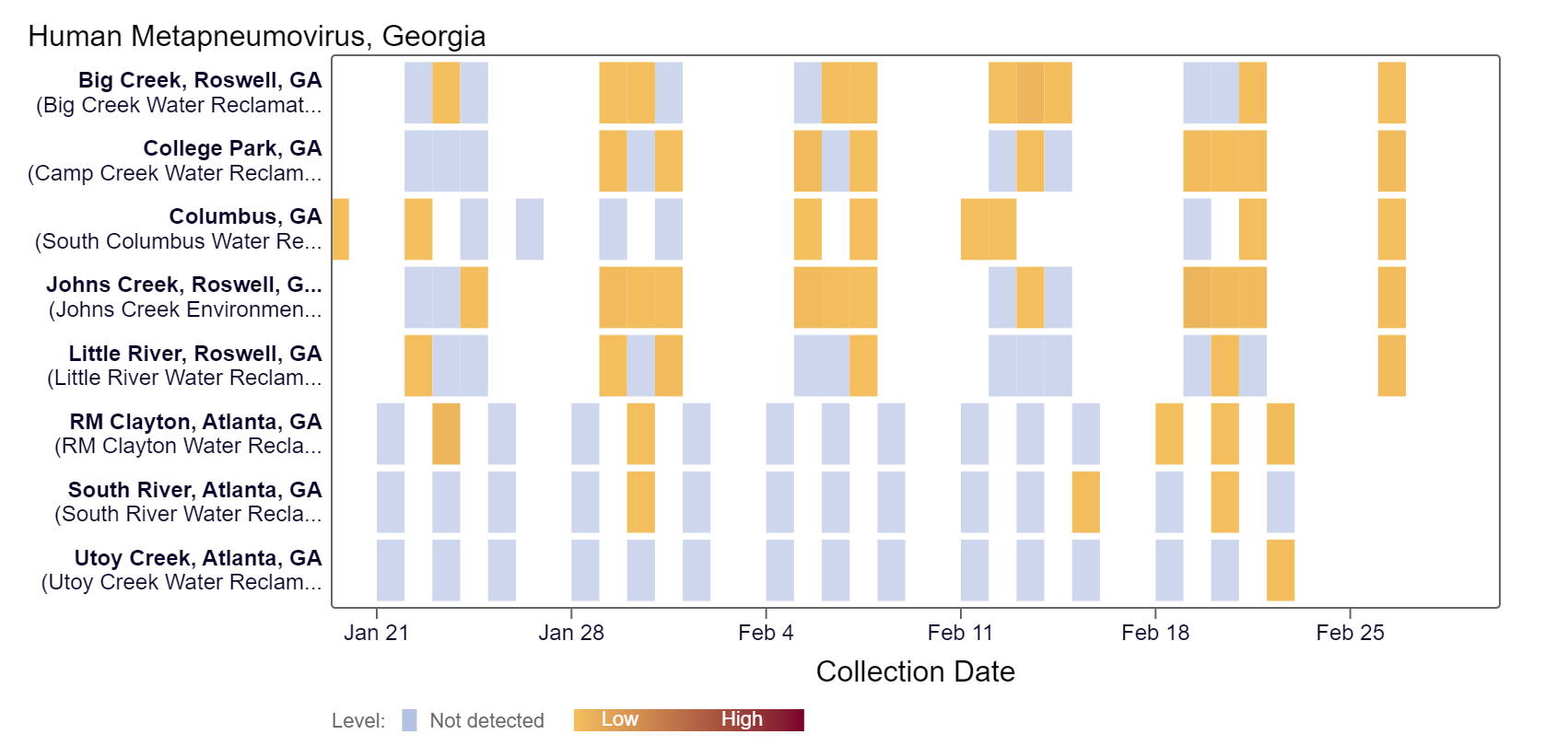
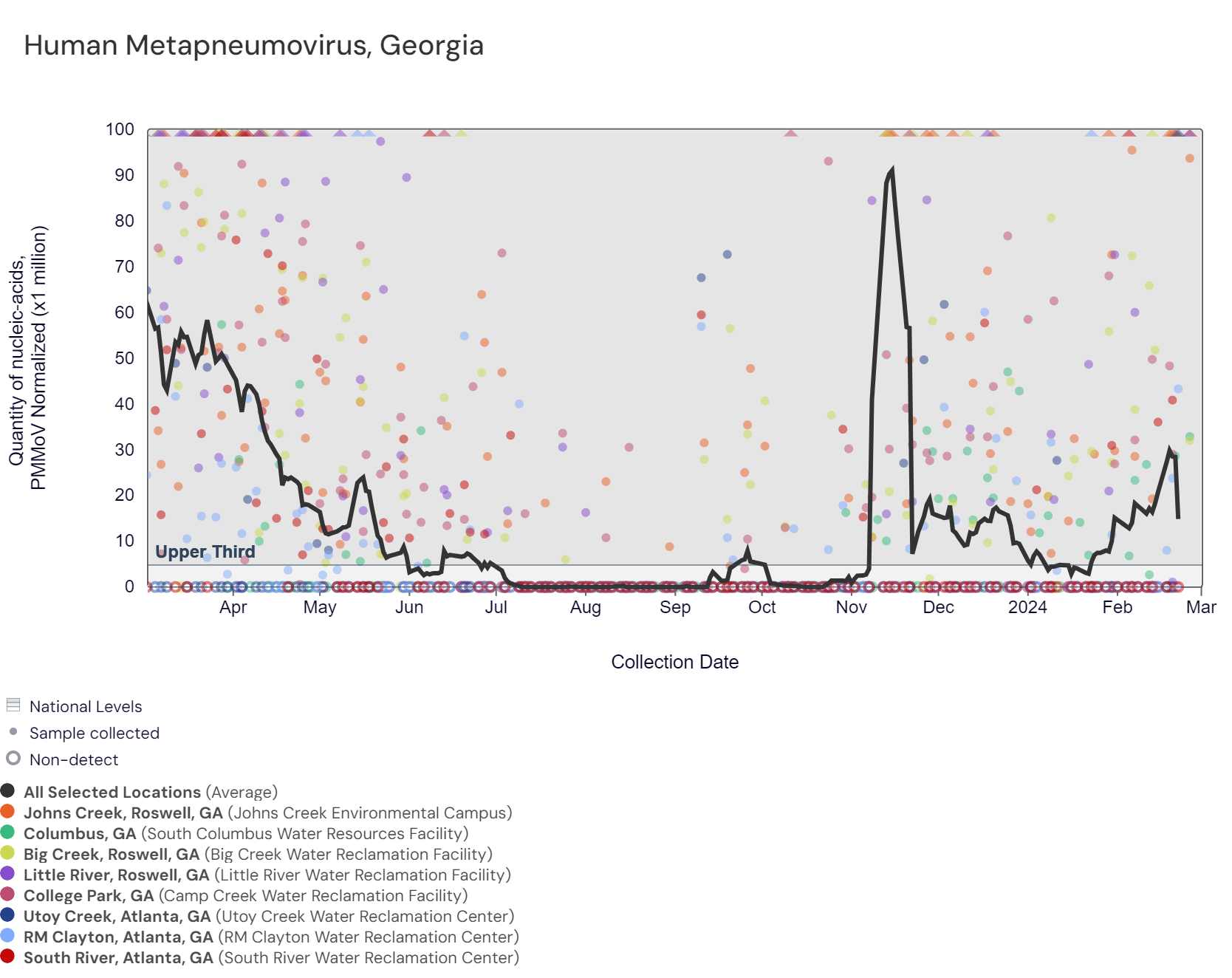
EV-D68 RNA is rarely detected at Georgia sites. Over the last two weeks, EV-D68 has not been detected, according to the heat map below. As a reminder, the color blue means the sample was non-detect for EV-D68 RNA and the colors get darker with higher concentrations. As of 3/1/24, College Park, Columbus, Little River, Big Creek, and Johns Creek are in the HIGH (5 sites) Wastewater category. There was not enough data to calculate a category for RM Clayton, Utoy Creek, and South River (3 sites).
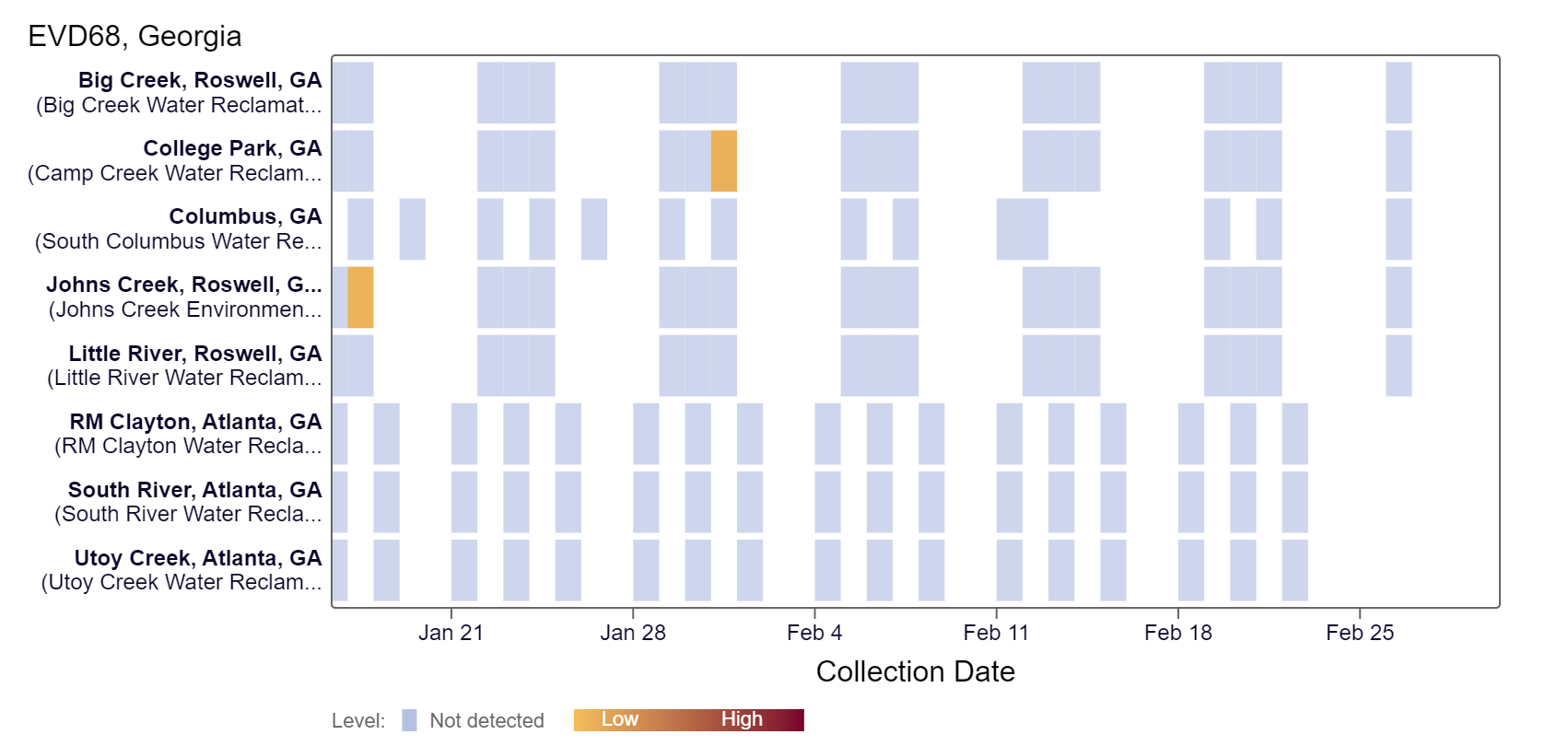
Parainfluenza RNA has been more frequently detected at lower concentrations in samples collected from some Georgia sites (Columbus, Johns Creek, & RM Clayton) but sporadically at other sites. Parainfluenza concentrations have been less than 34,000 copies/g. The chart below shows the raw data and the population-weighted aggregated trend line for all 8 Georgia sites when the data is normalized by PMMoV. Concentrations have decreased in Georgia over the last two weeks.
As of 3/1/24, College Park, Big Creek, and Johns Creek are in the HIGH (3 sites) Wastewater category. Columbus is in the MEDIUM (1 site) category. Roswell is in the LOW (1 site) category. There was not enough data to calculate a category for RM Clayton, Utoy Creek, and South River (3 sites).
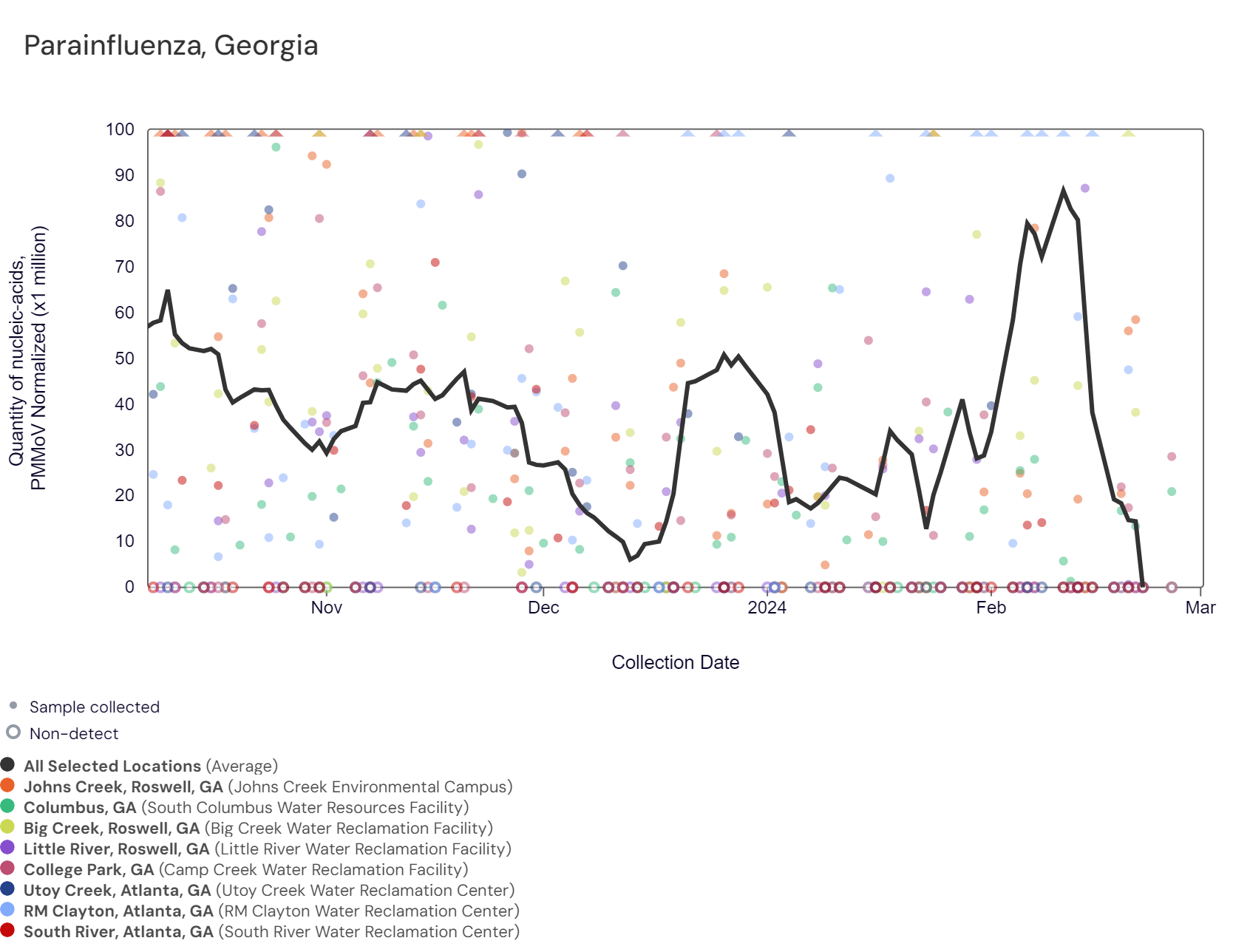
Gastrointestinal Pathogens
Norovirus GII and Rotavirus
Norovirus GII (HuNoV GII) RNA concentrations range between 8,300,000 - 51,000,000 copies/g, and the population-weighted average line for the 8 Georgia sites is within the upper third level. HuNoV GII RNA wastewater concentrations in Georgia are increasing, based on the trend line in the chart below. As of 3/1/24, College Park, Columbus, Little River, Big Creek, and Johns Creek are in the HIGH (5 sites) Wastewater category. There was not enough data to calculate a category for RM Clayton, Utoy Creek, and South River (3 sites).
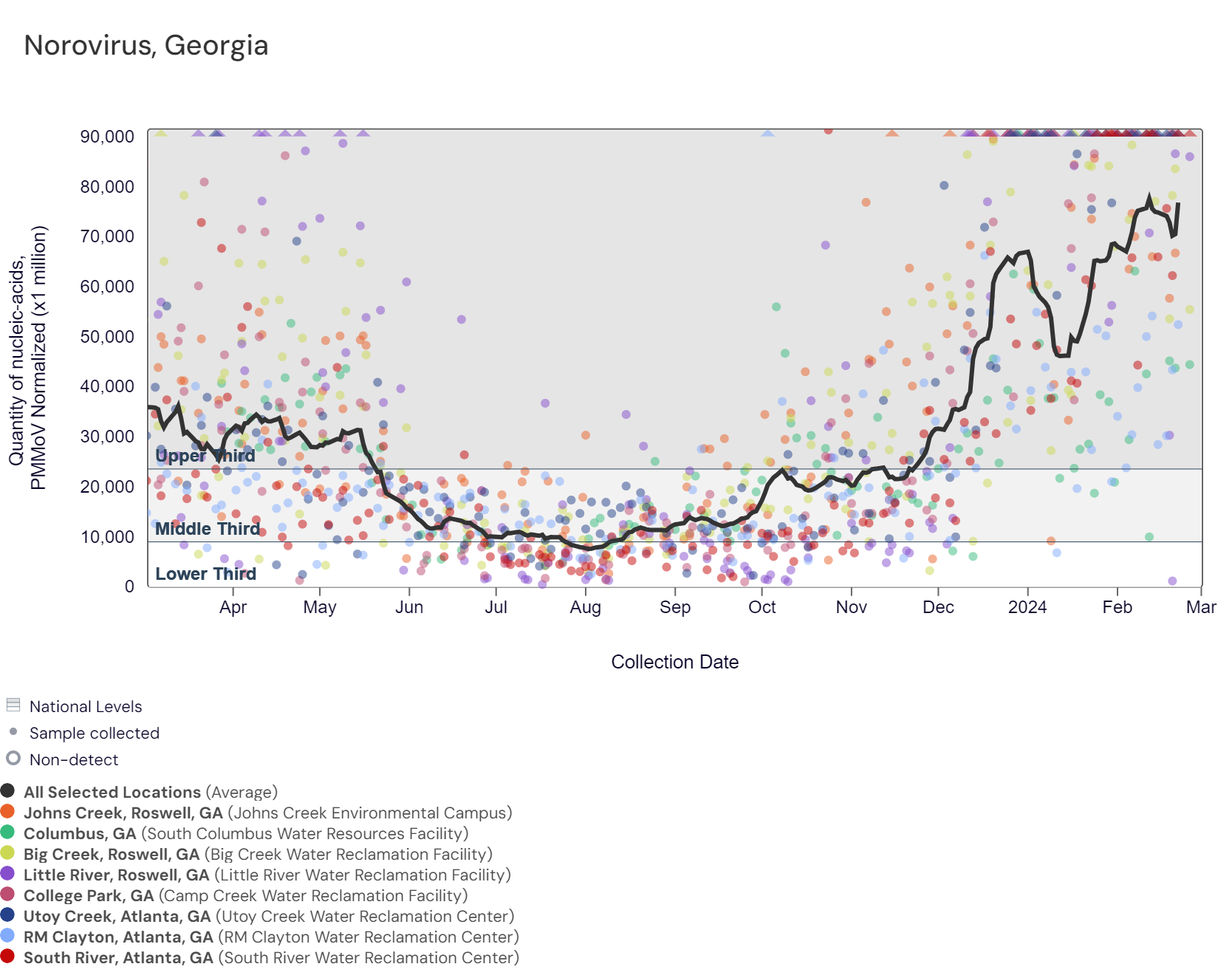
Rotavirus RNA concentrations have been between 200,000 - 2,700,000 copies/g over the last two weeks. The chart below shows the population-weighted average line is shown in black plus the raw data for each site. As of 3/1/24, College Park, Columbus, Little River, Big Creek, and Johns Creek are in the HIGH (5 sites) Wastewater category. There was not enough data to calculate a category for RM Clayton, Utoy Creek, and South River (3 sites).
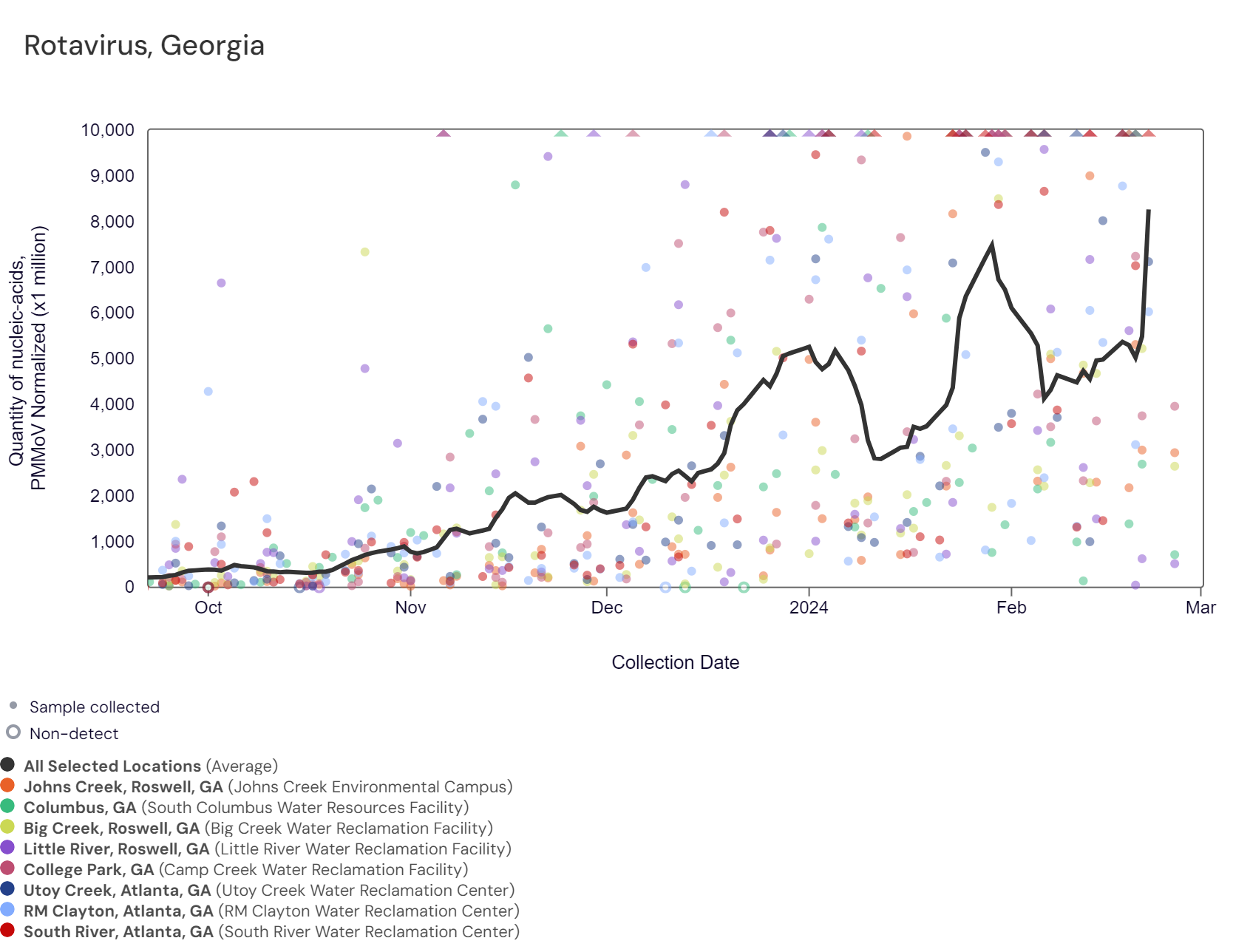
Other Pathogens of Concern
Mpox, Candida auris, and Hepatitis A
Mpox DNA results have been non-detect at all Georgia sites in the last 21 days. This heat map shows data since July 2022. Sites are labeled in the rows and each date a sample was collected as a column. The color blue means the sample was non-detect for mpox DNA and the color maroon means Mpox DNA was detected. White indicates no sample was collected. Most Georgia sites are in the LOW (5 sites) Wastewater Category as of 3/1/24.
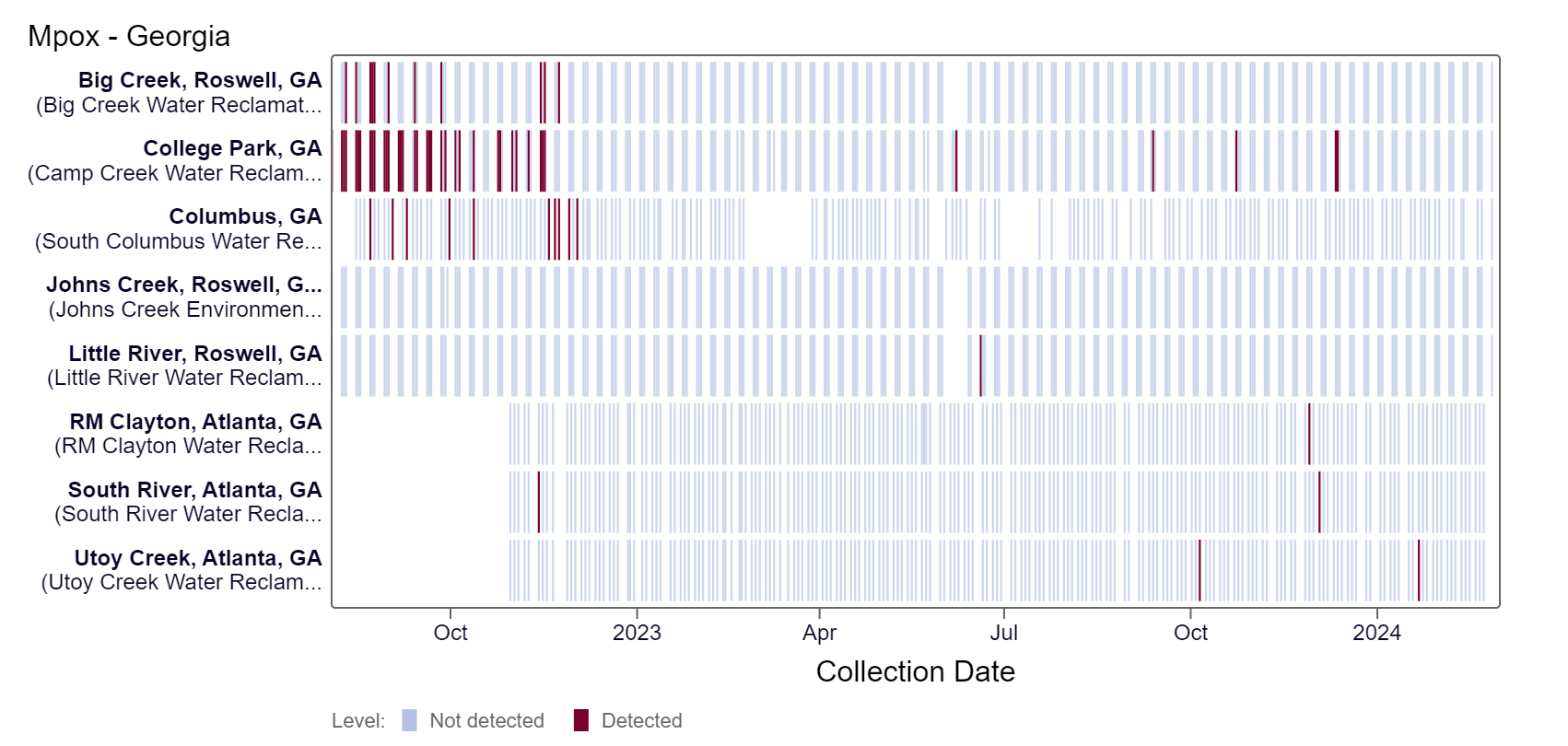
Candida auris DNA has only been detected at the Columbus site in the last two weeks, based on the heat map below. College Park, Columbus, Little River, Big Creek, and Johns Creek are in the LOW (5 sites) Wastewater Category, as of 3/1/24. There was not enough data to calculate a category for RM Clayton, Utoy Creek, and South River (3 sites).
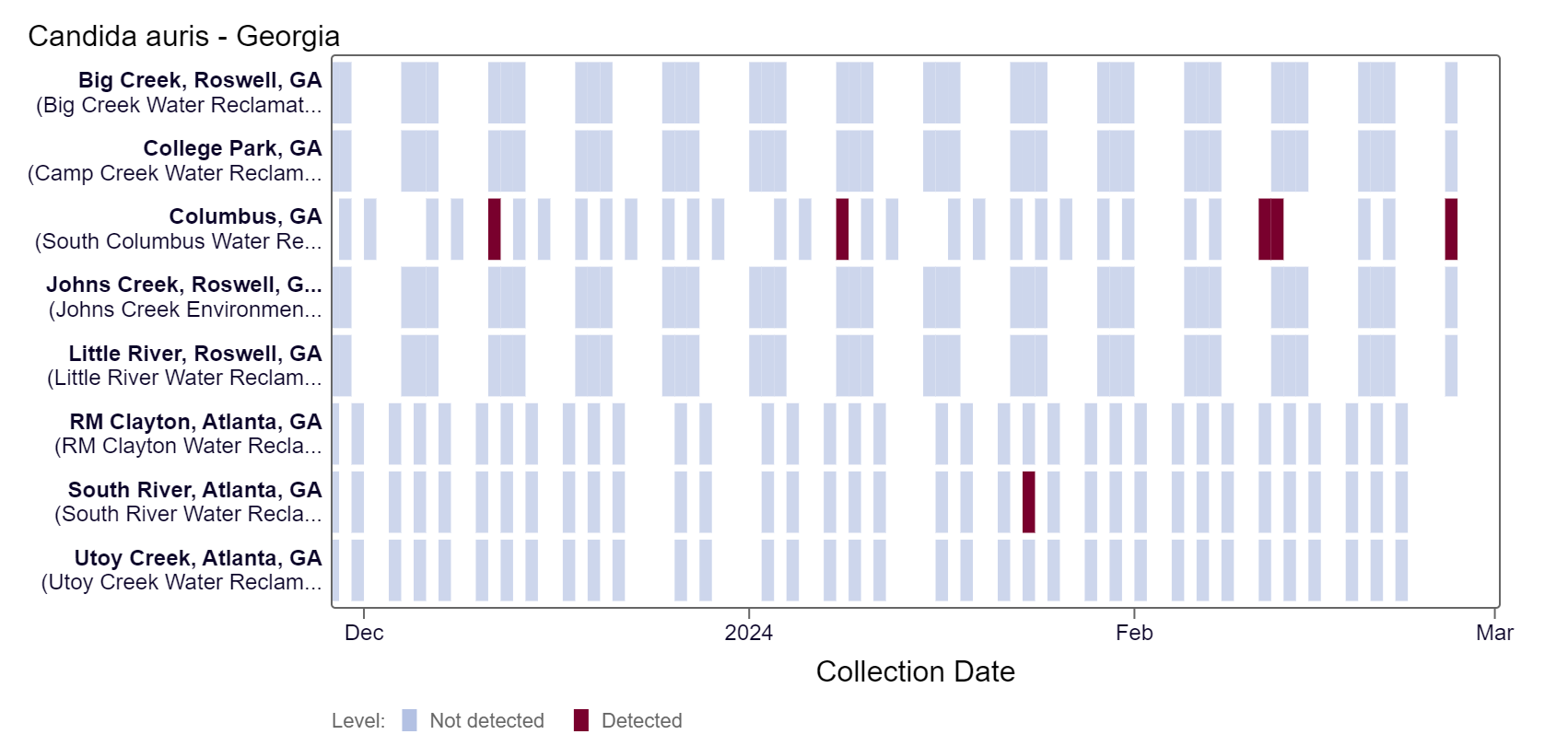
Hepatitis A RNA has been detected in samples collected from Columbus and RM Clayton over about the last two weeks, according to the heat map. As of 3/1/24, Columbus is in the MEDIUM (1 site) Wastewater Category. College Park, Little River, Big Creek, and Johns Creek are in the LOW (4 sites) category.
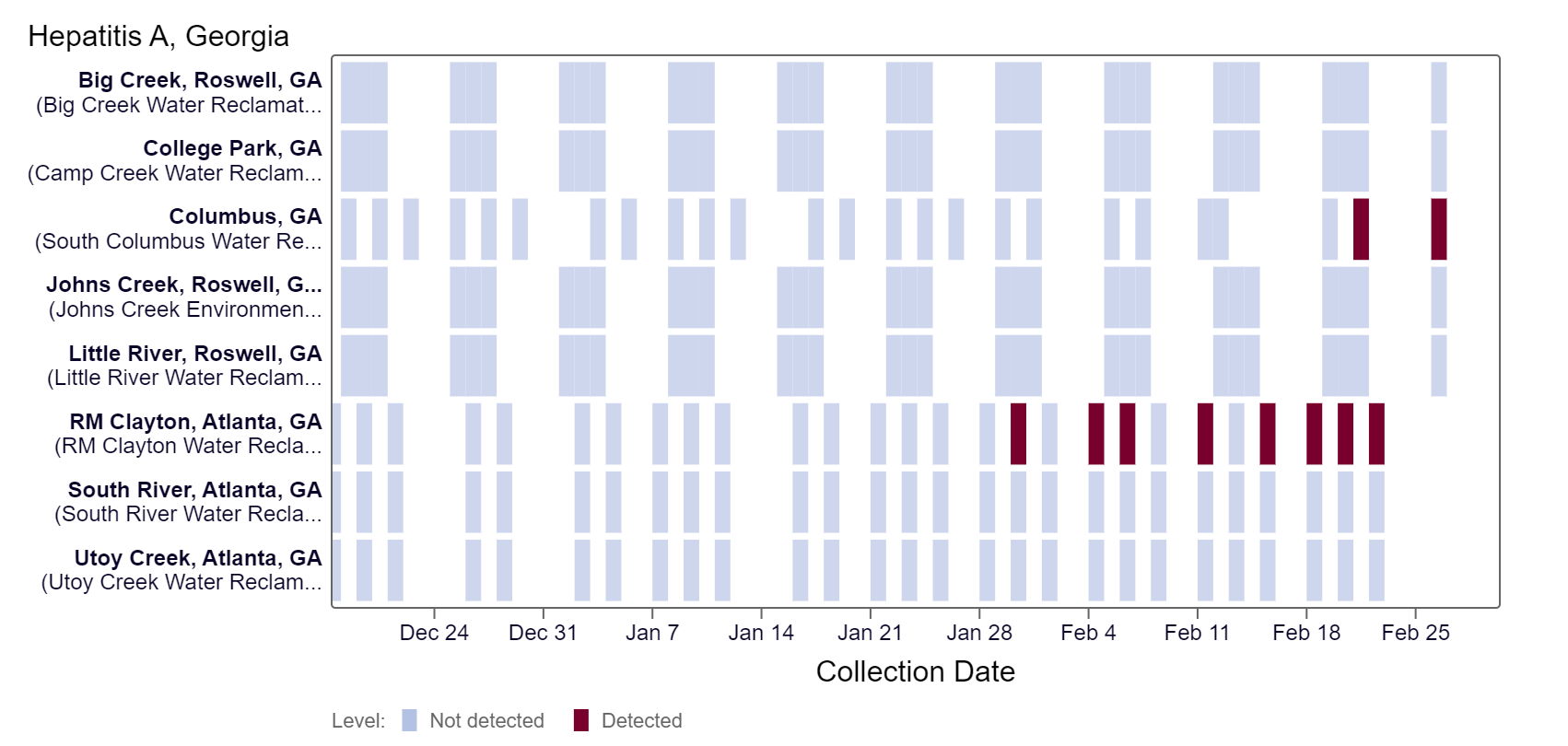
WWSCAN protocols and methods in peer reviewed publications
Protocols (Pre-analytical methods and SARS-CoV-2 analytical methods including controls):
- High Throughput RNA Extraction and PCR Inhibitor Removal of Settled Solids for Wastewater Surveillance of SARS-CoV-2 RNA
- High Throughput pre-analytical processing of wastewater settled solids for SARS-CoV-2 RNA analyses
- Quantification of SARS-CoV-2 variant mutations (HV69-70, E484K/N501Y, del156-157/R158G, del143-145, LPPA24S, S:477-505, and ORF1a Del 141-143) in settled solids using digital RT-PCR
- High Throughput SARS-COV-2, PMMoV, and BCoV quantification in settled solids using digital RT-PCR
Pre-prints and peer-reviewed publications provided WWSCAN methods:
- SARS-CoV-2
- Influenza, Human metapneumovirus, Respiratory syncytial virus, Human parainfluenza
- Mpox
- Norovirus GII
- Adenovirus group F, Rotavirus, Candida auris, Hepatitis A
- Enterovirus D68
Related News
The next stakeholder meeting will take place Friday, March 8th @ 12 PM EST. You can use this zoom link to join. Hope to see you there!
